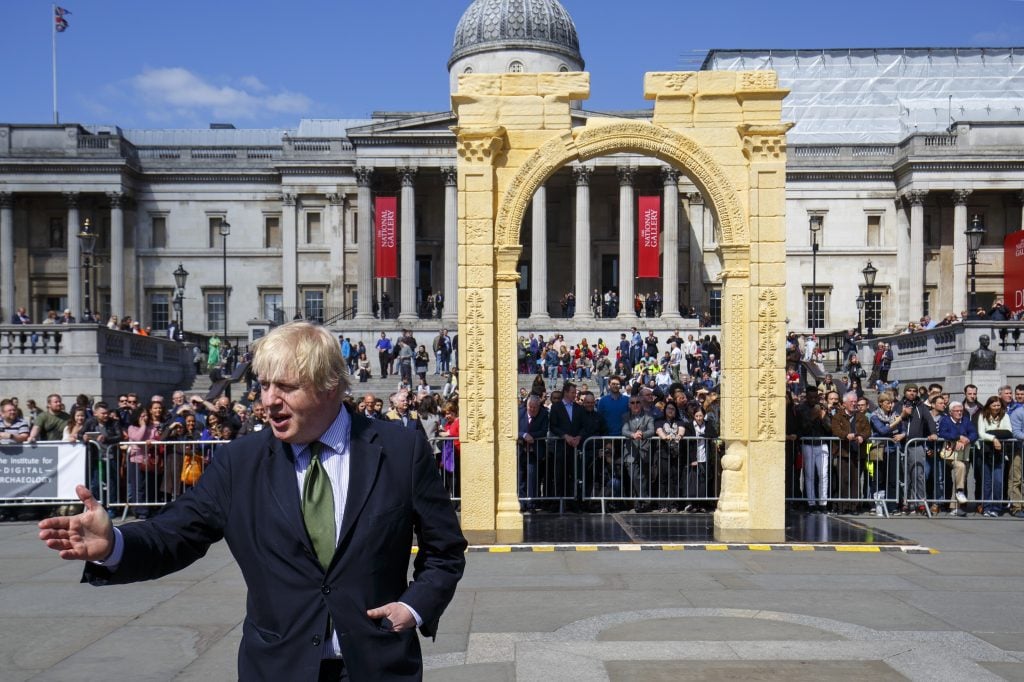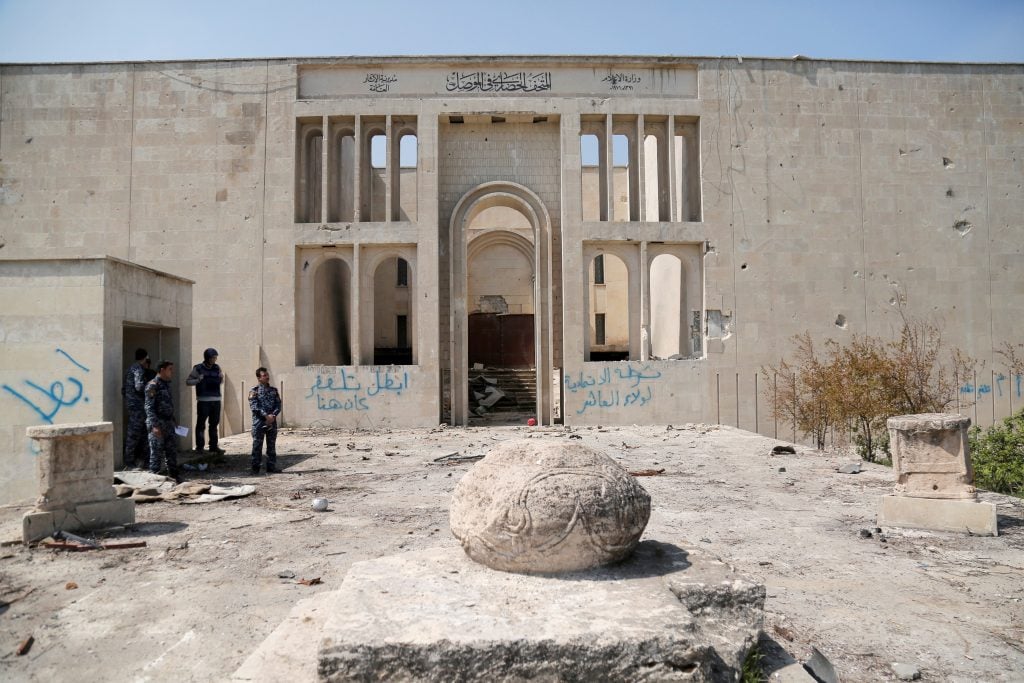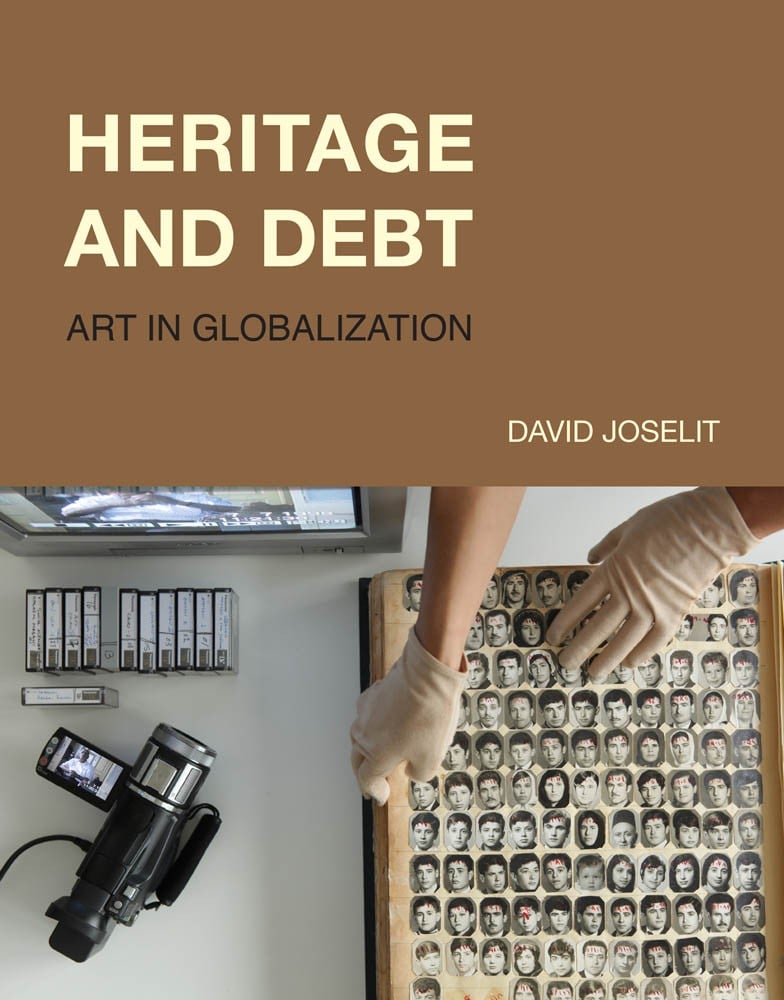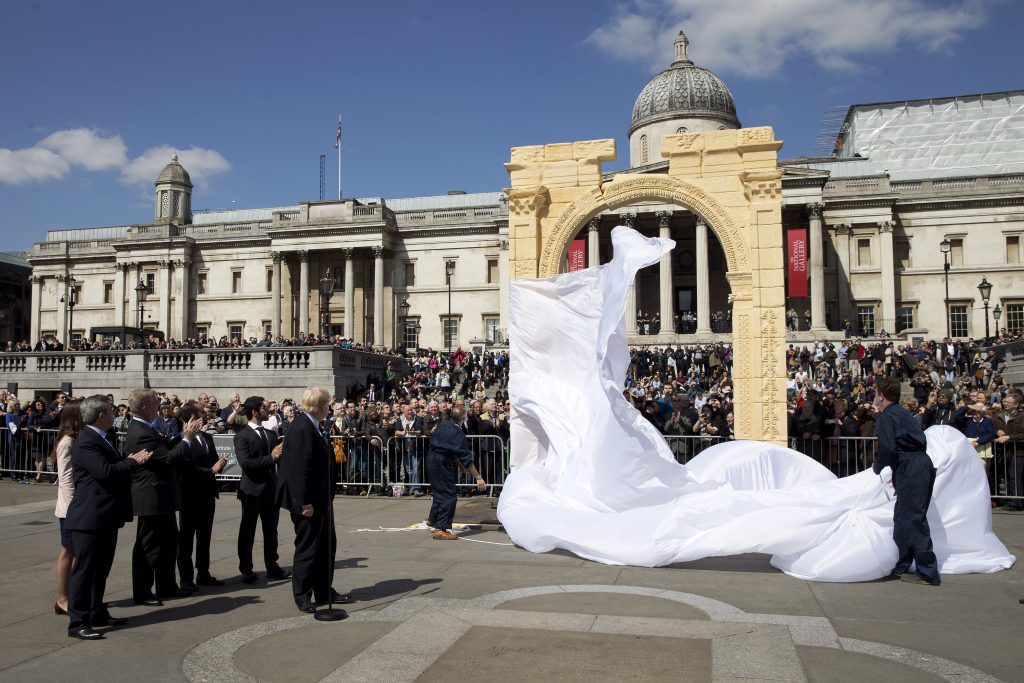Politics
How Western Nations Use the Arch of Palmyra and Other Symbols of Islamic Heritage as Political Tools
Read an excerpt from art historian David Joselit's new book, "Heritage and Debt: Art in Globalization."

Read an excerpt from art historian David Joselit's new book, "Heritage and Debt: Art in Globalization."

David Joselit

The role of museums in spectacular forms of colonization has been recognized—and contested—in iconoclastic acts like the destruction of the Bamiyan Buddhas by the Taliban in 2001, the bombing of archaeological sites in Palmyra, Syria, and the ransacking of the Mosul Museum in Iraq by ISIS in 2015. This resistance has taken the form of physically assaulting works of art and of “humiliating” them symbolically by selling them illicitly to raise funds, thereby abrogating their status as “sacred” museum artifacts deserving of eternal protection and conservation. Such acts of destruction and violence have been skillfully spectacularized both by the Taliban and ISIS in videotapes disseminated widely online in order to garner maximum attention and outrage from the West as well as solidarity among sympathetic partisans worldwide. Art historian Wendy M.K. Shaw, a specialist in Islamic cultures, compares these videos to museum documentaries. Other scholars of Islamic art and culture have specified the acts of iconoclasm they capture as precisely calibrated and historically informed reenactments rather than simply atavistic acts of barbarism that many Westerners see in them. The eminent historian of Islamic religious studies Jamal J. Elias, for instance, writes of the destruction of the Bamiyan Buddhas:
What started out as a vague iconoclastic impulse became sharply focused as a reenactment of prophetic tradition, the Abrahamic precedent being invoked not just in the iconoclastic act but also in the symbolism of sacrifice, since the deaths of children as a direct consequence of international sanctions evoked Abraham’s willingness to sacrifice his child for his monotheistic God.
The best of Artnet News in your inbox.

Mosul museum, which was damaged bu Daesh terrorists, seen after Iraqi army recaptured it, on April 2, 2017. Photo by Yunus Keles/Anadolu Agency/Getty Images.
Here Elias sounds a theme that is prominent among Muslim commentators but largely marginalized in Western accounts: that the outrage regarding the destruction of Middle Eastern heritage among Europeans and Americans ignores, and indeed ideologically suppresses, the human suffering caused by the region’s wars, including the “War on Terror” and its attendant economic sanctions. In short, Westerners are perceived to grieve the loss of sculptures but not of people. Hence, as Elias puts it, the sacrifice enacted on the Bamiyan Buddhas resonates with, and to some degree compensates for, the “deaths of children as a direct consequence of international sanctions.” In arguing that the videos produced by ISIS are not just ex post facto documents of iconoclastic actions but their very raison d’être, art historian Ömür Harmanşah also identifies a logic of reenactment: “These performances highlight a direct and bodily attack on the statues, and can be imagined as a re-enactment of the 7th century C.E. destruction of idols in the Ka’aba, which they frequently and explicitly cite.” Harmanşah understands this specific association within a broader logic of iconoclasm: “I propose that the element of iconoclasm exists in ISIS’s acts only as a historical reference, a rhetoric, and perhaps more powerfully as an archaizing re-enactment of the idea.” Finbarr Barry Flood has further identified the contemporaneity of these videos through their adherence “to codes and conventions drawn from a wide range of media genres, including movies, music videos, social networking sites, and video games.” The purpose of staging such historically charged reenactments rendered in contemporary idioms is precisely to produce a type of content susceptible to swift, inexpensive, and global distribution. In other words, as generators of affective images, ISIS’s destruction of cultural heritage functions in the same manner as the mirror museums I have discussed, but with a directly opposing message.

The cover of David Joselit’s new book Heritage and Debt.
Without justifying their heinous attacks on heritage—and I do not in any way condone them—it is important to acknowledge that, in their actions, ISIS accurately recognizes the ideological message of Western museum culture and its maintenance of a division between “curating cultures” and “curated cultures.” As anthropologist Jessica Winegar writes in her account of art’s role in delegitimizing political Islam: “art is [adduced as] prime evidence of a suitable bearer of Middle Easterners’ humanity, but it is a very particular definition of humanity that is advanced under the guise of a universal humanism. It is one that allows Middle Eastern Muslims to be human only in the past or only if they eschew political Islam or critique religion.” In other words, the museumification of Afghanistan’s or Iraq’s ancient past functions as an explicit weapon against contemporary forms of political Islam. Such ideological conflict has also been exploited by secular governments in the Middle East which have appropriated archaeological heritage as a means of asserting national sovereignty. Shaw, for instance, writes with regard to Iraq:
Under Saddam Hussein, the revival of Assyrian identity provided ancient precedent for a strong central state while providing a source of collective identity preceding all modern religious and ethnic groups in the region. In the 1950s, a reproduction of the Ishtar Gate (the original of which was excavated between 1902 and 1914 and is at the Berlin Pergamon Museum) was built as an entryway to the remnants of the city of Babylon. … The reproduction used bricks bearing the inscription, “This was built by Saddam, son of Nebuchadnezzar, to glorify Iraq.”
In short, what the Western exhibitionary complex presents as “universal”—whether in Europe or the Middle East—has a specific Eurocentric and secular profile, even when celebrating the arts of Islam, which is consonant with spectacular forms of recolonization. Reenactments of iconoclasm thus function in opposition not only to the mirror museum as an institution, but equally to a broader Western universal humanism whose “other” has shifted from Communism during the Cold War to political Islam after 1989, and especially after the attacks of September 11, 2001. What is important to underline, however, as the various Islamists I have cited insist, is that the particular type of iconoclasm practiced by the Taliban and ISIS is thoroughly contemporary in its calculated allusions and strategies of reenactment, as well as its canny use of digital media. Both terror and the corresponding war on terror are prosecuted in the realm of spectacle as well as physical space. Indeed, terror requires for its efficacy a developed media culture since it depends upon gaining exorbitant publicity for punctual and often relatively limited assaults. Terror, like one of its most beloved contemporary adversaries—the museum—is an engine of images.
Paradoxically, then, it is the mobility of heritage—its capacity to circulate in multiple forms as image and discourse—that allows it to participate in these spectacular “civilizational” contests. Just as Saddam Hussein had erected a modern version of the Ishtar Gate in the 1980s to replace the original reconstructed in Berlin in 1930, as both a riposte to Western museumification and an assertion of national sovereignty, a two-thirds-scale replica of the triumphal arch of Palmyra, destroyed by ISIS in 2015 appeared in London’s Trafalgar Square—the former epicenter of British imperialism—in April of 2016 on the initiative of the Institute for Digital Archaeology (IDA) based at Oxford University. Here Western sovereignty over world culture was asserted in order to delegitimize political Islam through a condemnation (and digital reparation) of its iconoclasm. Boris Johnson, then mayor of London, declared, “Antiquities like this belong to all mankind and it is imperative that we all strive to safeguard our common heritage.” He was echoed by the Syrian antiquities official, Dr. Maamoun Abdulkarim, who told CNN, “Palmyra is not for the Syrian people, it’s for all the people in the world.” These assertions offer justification for declaring the destruction of heritage a crime against humanity. And indeed, UN Security Council Resolution 2347 of 2017 states that “unlawful attacks against sites and buildings dedicated to religion, education, art, science or charitable purposes, or historic monuments may constitute under certain circumstances and pursuant to international law a war crime.” With the triumphal arch installed in London (and later in New York and Dubai), Palmyra’s heritage is claimed “not for the Syrian people [but] … all the people in the world”—or, in other words, the people of the Western world, whereas the human casualties of war will weigh more heavily on Syria, and the millions of refugees produced by the conflict there remain shunned in most parts of Europe and the United States. As a “grotesque Duchampian readymade,” the triumphal arch, which was produced through a process of digital modeling by the IDA, enacts the conflicting claims over rights to cultural property that is a central dynamic in global contemporary art. These claims are expressed through the medium of images—and more specifically, by generating streams of images in order to produce opposing publics. ISIS, as we have seen, arguably destroyed archaeological heritage specifically to generate propaganda images for itself—to create an extraterritorial identification with their sympathizers and potential partisans for their transnational caliphate. Meanwhile, the
digital reconstruction of Palmyra’s triumphal arch activated an equally extraterritorial domain—social media. Its reconstruction was based on “compiling dozens of photographs taken by archaeologists and tourists in Palmyra before the Islamic State moved in.” According to Stuart Burch, an art historian who specializes in heritage studies, these images were part of an initiative by the IDA called “The Million Image Database (MID), described as a collaboration between UNESCO, the government of the United Arab Emirates and a range of academic partners … [that] aims to distribute approximately 5,000 3D-cameras to volunteers who would
use them to document sites across the conflict zones of the Middle East and North Africa.” Here Boris Johnson’s claim that “Antiquities like this belong to all mankind” is literalized in the “crowd-sourcing” of heritage preservation. In this spectacular contest, iconoclasm is opposed to archiving, but both strategies—though ideologically opposed—insist on the actions of a citizen whose agency is linked to the production and consumption of images.

Mayor of London Boris Johnson (L) watches during the unveiling of a replica of Palmyra’s Arch of Triumph in Trafalgar Square, central London, on April 19, 2016. Photo: JUSTIN TALLIS/AFP via Getty Images.
The archiving organized by the IDA is distinctly narrow in both its temporal scope and its definition of what constitutes a document (i.e., a digital photograph). Burch, on the other hand, acknowledges a wider array of relevant materials:
Copious archives of artistic depictions and historical photographs capture [the triumphal arch of Palmyra] … in various states of preservation. Consequently, the object has existed in multiple guises through recorded history. An asynchronous composite reconstruction would retain memories of the life of the monument as opposed to simply how it just happened to have been constituted before its evisceration. Because, perversely, freezing the Arch of Palmyra at the juncture of its destruction risks playing into the hands of its nemesis. It is a crowning irony that a movement seeking to deprive other groups of their monuments should be gifted a memorial to their destructiveness.
Unlike its digitally designed reconstruction, then, Palmyra’s triumphal arch has assumed a range of different “guises” over time whose multiplicity presents a challenge to the historian: any reconstruction requires curatorial choices from a wealth of documents, all of which offer equally valid options but lead to distinctly different outcomes. Such indeterminacy is suppressed
by the IDA when it fixes the longue durée of archaeological heritage in the present tense of its (feared or actual) imminent destruction.
Excerpted from Heritage and Debt: Art in Globalization by David Joselit. Reprinted with permission from The MIT PRESS. Copyright 2020.